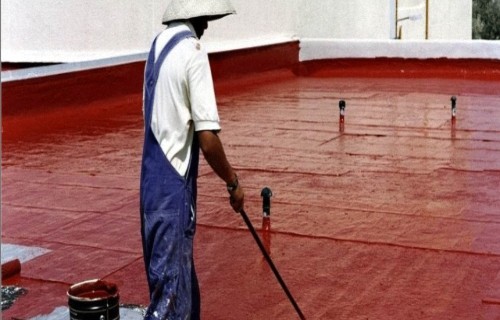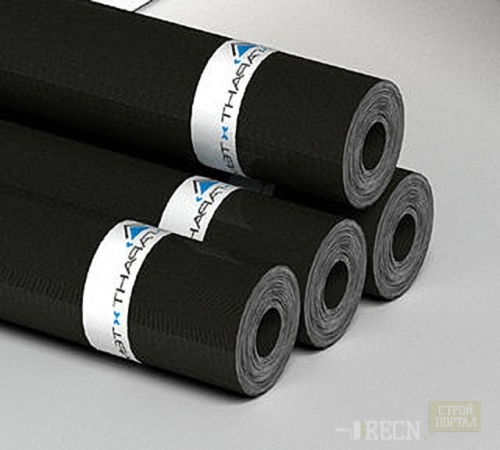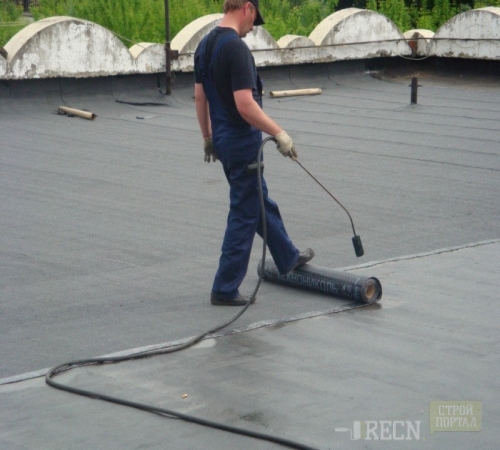
Soft rolled roofing Construction

It is worth saying that for insulation, strengthening and ensuring comfort in your home, the best option is a soft rolled roof. Its price is quite acceptable compared to other materials, and operational characteristics allow one of the most reliable materials.
Content
Technological aspects
Depending on the slope, the soft rolled roof is fitted as follows:
- the bias of more than 15 degrees - in two layers,
- a bias at 5-15 degrees - in three layers,
- if the slope of 0-5 degrees is four layers.
The largest slope of roofing rods for roll materials should be no more than 25 degrees. Usually, a soft rolled roof is installed on gentle or flat rods, where it is impossible to use other roofing materials.
For the soft rolled roofing device, it is necessary to prepare:
- primer
- mastic
- coating.
First stage - roof processing by mastic. For sticking rolled material to the base, hot and cold mastic applies. Cold bitumen mastic before laying, melted to an approximate temperature of 150-160 ° C. Hot mastic is usually melted to a temperature of 220 ° C, after that special powdered fillers are introduced, consisting of minerals (talc, tremble, diatomitis). When performing work, you need to take into account the supporting device for funnel of the inner drainage.
Adhesive cloth of soft rolled materials
For better gluing large pieces of rolled material, it is recommended to use related mastics. Different layers of rolling-roofing materials created on a bitumen basis glove, as a rule, bitumen mastic, and the Degtela compositions are accepted for Toli. In addition, it is worth considering:
- roof
- wind direction
- water drain direction,
- average air temperature,
- climatic features.
If the roof is up to 15 degrees, the canvas are pasted perpendicular to the flow of water, starting the sizing from the lower places of the roof.
If the roof slope is more than 15 degrees, the panels are glued in the direction of water flow from top to bottom. In this case, the roller carpet will not crawl. So the roof is stacked soft roller. Photo is recommended to look, and analyze before entering the installation process.
On the rods of the roofs, the roll panels are settled with a mustache. Namely - each new layer is obliged to close the joints of the elements of the lower layer. If the inclination of the roof from 5 degrees and more, the width of the fattest is obliged to be at least 70 mm in the inner layer of the carpet and 100 mm in the outer. If the slope is less than 5%, in all layers the width of the flake is made 150 and more mm. Rolls must be laid in one direction. When the roof is slightly 15 degrees, the work is performed by a mechanical way with a rolling machine. With a coolest skate, the work is performed solely manually.
If you decide to glue manually, here you need 2 people - "stacker" and "brush". The second is engaged in applying mastic on the inner surface of the panel and roof base. And the stacker must customize and glue the roof to the base of the roof. Work is performed according to the following scheme:
- the stacker freezes part of the roll, length from 3 to 6 m to a specific area of \u200b\u200bthe roof slide, after which it cuts off,
- the brush is as quickly as possible with hot, or cold mastic on the material, layer in 1-2 mm,
- the stacker gloves all the blurred surfaces, carefully smoothing the entire cloth with his hands or plastic spatula.
It is necessary to smooth into the direction from the middle of the roof to the edges. The stacker must acquire tarpaulin mittens that will protect their hands from getting hot mastic. After the end of the pasting, the edges of the cloth should be covered, and then rolling with a rink.
In case the bloating is formed during the pasting, it must be pierced with a seer, cut through, and then firmly press to the roof until the mastic flows. When laying the layers using cold mastic, the interval between the pasting of the new layer should be 12 hours minimal. The outer surface of the roofing bitumen carpet is covered with a mastic whose layer should be 3-5 mm.
It should be noted that all bitumen-polymer rolled products have an external protective layer. Polymer carpets are covered with a small lacquer layer of certain mastic. The process of sticking the roof of a soft roller is very energocatically and laborious, it is recommended to perform this work at least a brigade of 6 people.
After installing the cornis blocks, the transition wooden bar is laying, right on the eaves at home. This timber is covered with steel sheets designed for roof. In addition, tray brackets for laying a gutter stripping to brackets are attached to the ectile. The drain bar of the eaves is similarly covered with steel sheets. As a result, the carnome svs is ready for pasting with rolled material. Additional cloth must be glued along the front-bottom sink. Rolled stripes are stacked on it. In addition to all, klimmers are fixed to the sink, which keep the entire roofing apron to themselves. Repair of a soft rolled roof is carried out in a similar way, with the help of the same materials.
Coating of endands and rapid
Given the fact that the rtandov and the suspension have the smallest bias, they are usually covered in four, or, even five layers of a rolled material. At the same time, the three necessary extra layers are glued in turn after each other. Related sheets of material in the layer are closed each other, approximately 100 mm. The upper layers must be glued, alternating them with scanty cloths. In the event that the slope of the roof stick is more than 15%, then here all three layers are glued in the sliding one by one by one, while they are mounted in a plug on a slightly binding. If the slope of the adjacent slide is less than 15 degrees, then all the layers are easily mounted on the skate.
If the width of funds up to 600 mm (narrow endands), they are glued with long slices. With a width of rtands, more than 600 mm (wide endands) - occurrence with strips of arbitrary length occurs. Moreover, it should be stacked. The sticker is carried out in the direction from the drain funnel to the watershed.
Coating the ridge of the roof
If the roof of the roof has a slope of less than 15 degrees, it is covered by the panels, which are placed perpendicular to the drain. With a bias of more than 15 degrees - parallel to water flow. There are two ways to lay a soft rolled roof.
The first way to cover the roof of the roof implies:
- singing the lower layer of the rolled carpet, smoothly, at the ice, is the first layer,
- the second layer should be 400 mm wide, and it is also an inner skate cloth,
- the third layer consists of two cloth, as well as the previous two, and also glued,
- the fourth layer is the second skate cloth, whose width should be 500 mm,
- the fifth layer consists of two rolled outdoor cloths, which also fit into the junction,
- the sixth layer is the upper skate cloth, its width should be 600 mm.
The second way of covering the rod of the roof implies the sticker of all outer and inner layers perpendicular to the skate. At the same time, it is necessary to connect each layer through the horse, in 200 mm (internal layers) and 250 mm, if the layers are external. The adjoining of the layers of a soft rolled roof to the vertical walls is possible in two ways:
1. The first is a mustache. Each rolled cloth is glued by a special method. All layers must rest in the transitional inclined plane, and end on it. The "closures of the adjoint" are pasted on top. The ends of the "cloth adjoits" are strengthened with bell nails to a prematurely prepared and installed wooden rail, which is processed by protective antiseptics. The upper part of the cloth closes with an apron from ordinary roofing steel.
2. The second method is in the plug. The sheets of a roll carpet, like the "cloth of adjoining" glue on the base of the wall and roofs alternately. It is necessary to attach the top ends of the cloth with nails to the same wooden rail, as in the first way. At the end, the upper part is closed with a metal apron.
It is worth noting that in both cases before the sticker material, the whole roof is a soft roller folded in half. Mastic is applied on both rented half in turn. Then, the edges of the cloth are sprinkled with the extruded mastic from the sides. The conjugation of a roll material with a variety of pipes is produced using inclined sideborks installed around the pipe. In such a situation, the top edge of the carpet is closed with a metal apron. The apron itself is attached to the pipe with a coupling clamp.






![11 [640x480]](https://recn.ru/images/recn/2014/01/11-640x480.jpg)
















